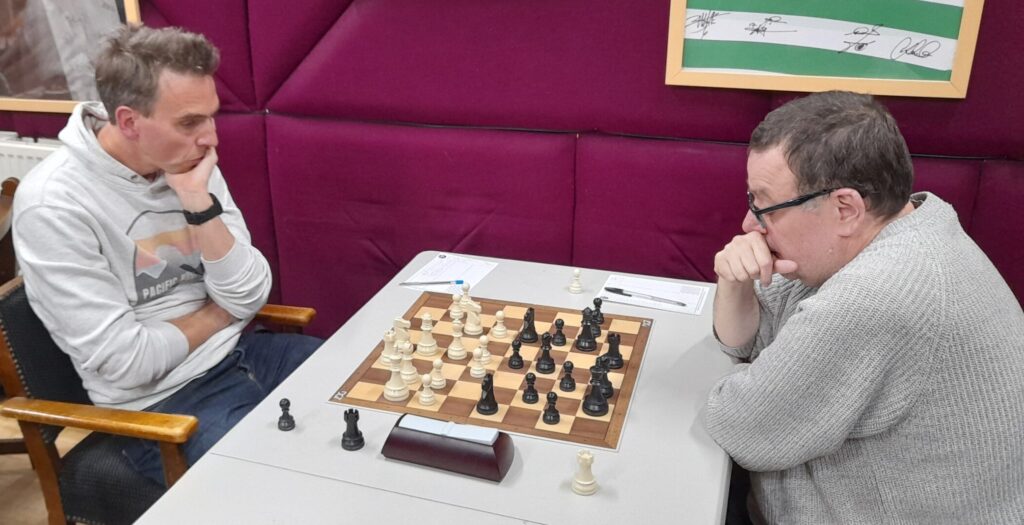Thames Valley League division 1 match played at the Willoughby Arms, Kingston on 23 October 2023
This season the Thames Valley League brought in a major new rule change: there is no longer the ritual pre-match toss for colours; instead, home teams always have Black on odd boards. There has been some discussion as to whether this enables better opening preparation, as all the players now know in advance whether they will be White or Black. However, what no one knows beforehand is the composition of the other club’s team. You may find yourself playing the same opponent as last year (this was more or less my situation on Monday, but with colours reversed and on a higher board) and you may find that the other club is deploying all their strongest players in exact rating order. On the other hand, it’s quite likely that neither of these two situations will occur. In the Thames Valley it’s also possible for teams to order their players more flexibly, less predictably, than in the Surrey League.
On Monday Wimbledon turned up at the Willoughby with their strongest possible board 1, Alberto Suarez Real, an IM with a Fide rating of 2408. However, their team overall was missing some of its stalwarts from previous years. In the circumstances, facing a Kingston team which outrated them by an average of 141 points per board, Wimbledon put up a good showing, and it was only near the end of the three-hour session that Kingston’s win was assured.
The shortest game was in fact on board 1, where Peter Lalić played the Scandinavian Defence, except not as a defence, but as a gambit, giving up a pawn for quick development. His Spanish IM opponent used up a lot of time on the opening, and the players agreed a draw after just 12 moves. A very good result for Peter and the team.
The next game to come to a premature end was on board 6, where John Foley reached this position from what chess.com non-committedly calls “Indian Game”.
Stockfish evaluates this as roughly equal, but Black needs to be careful as White has a massive threat. Stephen Carpenter overlooked this, playing 25….Rg8 (Ne7 or Qe7 was necessary), and John was able to play the satisfying 26. Nxe6! If Black takes the knight White mates in two with Qxg6+. If he doesn’t take he’s lost the exchange (and more) in addition to the e6 pawn, so Carpenter just resigned. 1.5-0.5 to Kingston.
Three of the remaining four games involved a lot of slow manoeuvring. The exception was on board 2, where David Maycock won two pawns early on against Ian Heppell’s Philidor Defence and castled queenside. In the position below he decided to give up the exchange in order to maintain his strong centre. 22. Ne2 instead would only have given White a slight plus.
The game continued 22. Be3 Bxd1 23. Qxd1 Qc6 24. Nf4 Bb4 25. Rg1 Qb7. White’s pieces are gathering ominously on the kingside.
David now played 26. Ka1, presumably so as to be able to move his knight to f5 without allowing 26…Qe4+, forcing White to interpose with his queen, 26. Nf5 Qe4+ 27. Qd3 Qxd3+ 28. Nxd3. It seems that this position would still have been better for White due to his pawn centre and the threats to b4 and g7. Black’s only defence, 28…Bf8, allows 29. Nh6+ Kh8 30. Nxf7+ winning another pawn. After 26. Ka1 the game actually continued 26…Bf8 27. h4 Rb8. Now Black is starting to have his own threats against White’s castled king.
Meanwhile, things were much less double-edged on the other boards. Will Taylor had played a Petrov Defence and both sides were gradually trying to develop their pieces to their best squares. On board 4 I had won the minor exchange (bishop for knight), but with a symmetrical pawn structure was having difficulty making anything of it. In the position below, Black controls the d-file, but can’t make effective use of this, so I played 24. Kf2 (overprotecting my f-pawn) in anticipation of Black’s next move.
After 24…Qd3 25. Qxd3 Rxd3 26. Rc1 I am going to force Black’s rook out with Bf1 and then try to increase my slight advantage on the queenside. I probably didn’t find the best way to do this (Stockfish recommends a quick advance of White’s a-pawn), as by move 38 it was clear that Black was at least equal and we agreed a draw.
The Ingle-Way game, in which Julian played a King’s Indian Defence, featured a similar symmetrical pawn structure. However, the position opened up around move 25 and Julian gained the advantage. In time trouble the tactics became harder to calculate and both sides missed chances before Sean Ingle committed the final mistake and soon after lost on time. This was actually the last game to finish and it assured Kingston’s victory in the match.

Meantime, the board 3 Cannon-Taylor game had ended with both sides being content, or obliged, to repeat moves. There was also a repetition in the board 2 Maycock-Heppell game, but this was much less pacific. Black’s queenside attack became more dangerous than White’s kingside one, with the consequence that the position below was reached.
The game finished 37…Nc2+ 38. Kb1 Na3+ 39. Ka1 Nc2+ 40. Kb1 Drawn. However, Black could have continued with his dangerous attack instead of repeating. A forcing line is very hard to see unless you are a chess engine, but 38…Qe4 is difficult to meet.
Thus Kingston won 4-2, but Wimbledon had fought hard and the match would probably have been even closer if one of their top players had not had to drop out on the morning of the match: another reason why guessing the opponents’ line-up is often a toss-up, so to speak, though we can still try.
David Rowson, Kingston A captain in Thames Valley League division 1

